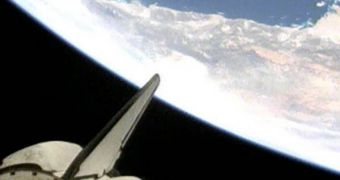Crew members aboard the newly launched space shuttle Atlantis have begun to conduct their first inspection of the craft's heat shield a few hours ago, an event that has become standard procedure since the Colombia accident, back in 2003. The investigation has even more meaning for Atlantis than it had for Discovery a couple of months ago, because the shuttle is heading for the Hubble Space Telescope, which means that the International Space Station will no longer be available as a back-up, in case something is to go wrong.
For this operation, the crew will use the same type of sensor-laden poles employed by Discovery, and will scan the entire underbelly of the spacecraft, from the tip of the wings to the end of the nose. The goal of the investigation is to determine whether there are any loose fragments of insulating material, or if the debris caused by the launch has damaged any of the orbiter's systems. The integrity of the heat shield is the most important aspect of a shuttle, NASA engineers say, because no miracle can save a craft if it starts atmospheric reentry without a fully operational one.
The only contingency that the STS-125 mission has is the space shuttle Endeavor, which is currently in position and ready to assist at Launch Pad 39B, at the Kennedy Space Center. Dubbed STS-400, the mission will only blast off if Atlantis becomes critically damaged by micro-asteroids, or if the heat shield check reveals catastrophic damage. If it launches, Endeavor will have to make a series of complicated maneuvers, aimed at allowing it to dock to Atlantis, and safely transport the first orbiter's crew into its own cargo bay.
According to Bill Gerstenmaier, the chief of NASA's space operations, minute amounts of debris were observed falling from Atlantis' wings and fuel tank, but preliminary results from the pole analysis have revealed that the damage is insignificant. However, the shuttle crew will not miss any precautionary measures. Since Colombia was destroyed by a failed shield, all other missions that use shuttles to go to orbit need to verify theirs two times – first after reaching a stable orbit, and the second time just prior to reentry.
During their 11-day mission, the seven astronauts aboard Atlantis will repair two of Hubble's instruments, install a new panoramic camera and a high-tech spectrograph, replace six of its gyroscopes, all of its batteries, and also add a new thermal insulation layer. The repairs will ensure that the telescope will remain active until at least 2014, making the most famous telescope in Earth's orbit even more competitive than before.

 14 DAY TRIAL //
14 DAY TRIAL //